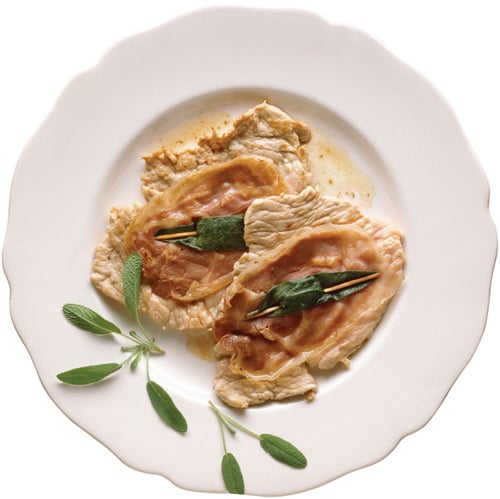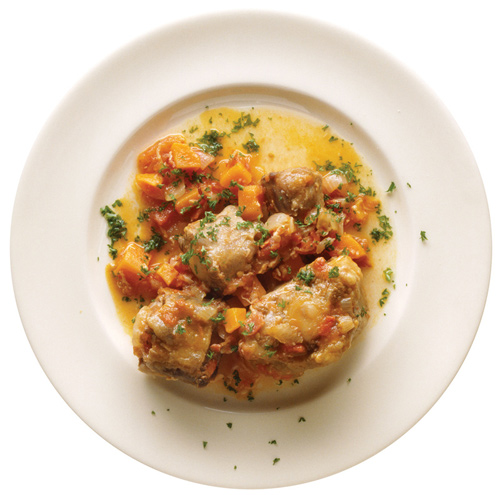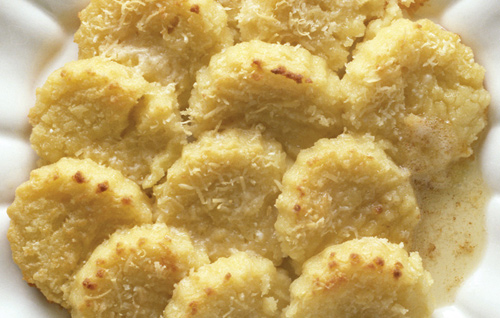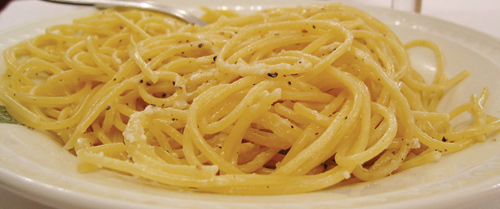Saltimbocca This
savoury veal dish is so good they call it “jumps-in-the-mouth”. A veal
escalope is layered with sage leaves and prosciutto then sautéed in
white wine.

Bucatini all’amatriciana Named
after Amatrice, the northern Lazio town high in the Abruzzi mountains
where it originated. The sauce consists of tomatoes mixed with Italian
bacon – guanciale (pork cheek) or pancetta
(pork belly) – laced with chilli pepper and liberally dusted with
grated Pecorino romano cheese. The classic pasta accompaniment are bucatini (thick, hollow spaghetti). The original amatriciana bianca version (before tomatoes, a New World food, entered Italian cuisine) adds parsley and butter. Carciofi alla romana Tender Italian artichokes, often laced with garlic and mint, are braised in a mixture of olive oil and water. Abbacchio scottadito Roasted Roman spring lamb, so succulent the name claims you’ll “burn your fingers” in your haste to eat it. When abbacchio (lamb) is unavailable, once the spring slaughter is over, they switch to less tender agnello (young mutton). Spaghetti alla carbonara The
piping hot pasta is immediately mixed with a raw egg, grated Parmesan
and black pepper so that the eggy mixture cooks on to the strands of
spaghetti themselves. It is then tossed with pieces of pancetta
(bacon). There’s a local legend that the recipe was born out of US army
rations after World War II (powdered bacon and eggs mix), but no one
seems to have proven or discarded the theory.

Spaghetti alla carbonara
Carciofi alla giudia Artichokes,
first flattened then fried. This typical Roman Jewish dish is often
accompanied by fried courgette (zucchini) flowers stuffed with
mozzarella cheese and anchovies. Pajata It
may sound revolting but it’s actually delicious: suckling calf
intestines boiled with its mother’s milk still clotted inside. Usually
the intestines are chopped, coated with a tomato sauce and served over
pasta. Coda alla vaccinara Oxtail braised in celery and tomato broth. Like pajata, this is a product of trying to make something out of the quinto quarto
(the unusable “fifth fourth” of the day’s butchering), which was part
of the take-home pay of 19th-century slaughterhouse workers. Checchino
dal 1887, the restaurant that came up with this delicacy, is one of
Rome’s finest .

Coda alla vaccinara
Gnocchi Dense
and bite-sized potato and flour dumplings, gnocchi originated in
Northern Italy but have infiltrated nearly every regional cuisine.
Rome’s version of the dish is made with semolina and/or corn flour,
doused in butter and parmesan and oven-baked. The original gnocchi are
served much more frequently, however. Try them with tomato sauce,
gorgonzola cheese or simply “burro esalvia” with butter and sage.

Gnocchi
Cacio e Pepe Sometimes the simplest dishes are among the best. Perfectly al dente
(“with a bite”) spaghetti is tossed hot with cracked black pepper and
grated Pecorino romano (a local sharp, aged sheep’s milk cheese rather
similar to Parmesan).

Top 10 Wines and Liqueurs
Frascati Lazio’s only high profile wine, a dry, fruity, not always perfect white from the hills south of Rome. Castelli Romani Cousin to Frascati, from neighbouring hilltowns, also made with Trebbiano grapes. Colli Albani Another Trebbiano-based white from the slopes of Lazio’s dormant volcano. Orvieto Classico Dry white from southern Umbria – so good that the Renaissance artist Signorelli once accepted it as payment. Est! Est! Est! A
bishop’s taste-tester, sampling this sweet white in a northern Lazio
lakeside village, excitedly ran to the door and scribbled “Est! Est! Est!” (Latin for “This is it!”). Torre Ercolana One of Lazio’s unsung reds, made from Cabernet and Cesanese grapes. Chianti This old favourite from over the border in Tuscany is one of the most common reds you’ll find in Rome’s bars and restaurants. Lacrima Christi “Tears of Christ”, a white wine from the slopes of the infamous Mount Vesuvius near Pompeii . Campari A bitter red apéritif, best diluted in soda water, or lemonade for a sweet drink. Grappa The most powerful of Italy’s digestivi (drunk after a meal), this is quite a harsh-tasting liqueur.
|